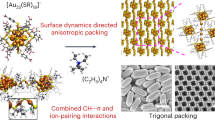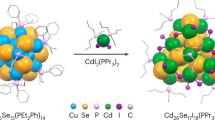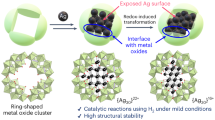Abstract
Superstructures with nanoscale building blocks, when coupled with precise control of the constituent units, open opportunities in rationally designing and manufacturing desired functional materials. Yet, synthetic strategies for the large-scale production of superstructures are scarce. We report a scalable and generalized approach to synthesizing superstructures assembled from atomically precise Ce24O28(OH)8 and other rare-earth metal-oxide nanoclusters alongside a detailed description of the self-assembly mechanism. Combining operando small-angle X-ray scattering, ex situ molecular and structural characterizations, and molecular dynamics simulations indicates that a high-temperature ligand-switching mechanism, from oleate to benzoate, governs the formation of the nanocluster assembly. The chemical tuning of surface ligands controls superstructure disassembly and reassembly, and furthermore, enables the synthesis of multicomponent superstructures. This synthetic approach, and the accurate mechanistic understanding, are promising for the preparation of superstructures for use in electronics, plasmonics, magnetics and catalysis.

This is a preview of subscription content, access via your institution
Access options
Subscribe to this journal
Receive 12 digital issues and online access to articles
$119.00 per year
only $9.92 per issue
Buy this article
- Purchase on Springer Link
- Instant access to full article PDF
Prices may be subject to local taxes which are calculated during checkout






Similar content being viewed by others
Data availability
The data supporting the findings of the study are available in the paper and its Supplementary Information. Source data are provided with this paper. Crystallographic data for the structure reported in this Article have been deposited at the Cambridge Crystallographic Data Centre, under deposition number CCDC 2157579. Copies of the data can be obtained free of charge via https://www.ccdc.cam.ac.uk/structures/.
References
Boles, M. A., Engel, M. & Talapin, D. V. Self-assembly of colloidal nanocrystals: from intricate structures to functional materials. Chem. Rev. 116, 11220–11289 (2016).
Li, Z., Fan, Q. & Yin, Y. Colloidal self-assembly approaches to smart nanostructured materials. Chem. Rev. 122, 4976–5067 (2021).
Urban, J. J., Talapin, D. V., Shevchenko, E. V., Kagan, C. R. & Murray, C. B. Synergism in binary nanocrystal superlattices leads to enhanced p-type conductivity in self-assembled PbTe/Ag2Te thin films. Nat. Mater. 6, 115–121 (2007).
Dong, A., Chen, J., Vora, P. M., Kikkawa, J. M. & Murray, C. B. Binary nanocrystal superlattice membranes self-assembled at the liquid–air interface. Nature 466, 474–477 (2010).
Koleilat, G. I. et al. Efficient, stable infrared photovoltaics based on solution-cast colloidal quantum dots. ACS Nano 2, 833–840 (2008).
Talapin, D. V., Lee, J. S., Kovalenko, M. V. & Shevchenko, E. V. Prospects of colloidal nanocrystals for electronic and optoelectronic applications. Chem. Rev. 110, 389–458 (2010).
Wang, P. et al. DNA origami guided self-assembly of plasmonic polymers with robust long-range plasmonic resonance. Nano Lett. 20, 8926–8932 (2020).
Ross, M. B., Ku, J. C., Vaccarezza, V. M., Schatz, G. C. & Mirkin, C. A. Nanoscale form dictates mesoscale function in plasmonic DNA–nanoparticle superlattices. Nat. Nanotechnol. 10, 453–458 (2015).
Lan, X. & Wang, Q. Self-assembly of chiral plasmonic nanostructures. Adv. Mater. 28, 10499–10507 (2016).
Kuzyk, A. et al. DNA-based self-assembly of chiral plasmonic nanostructures with tailored optical response. Nature 483, 311–314 (2012).
Shishou, K., Zhiyong, J., Nikles, D. E. & Harrell, J. W. Synthesis, self-assembly, and magnetic properties of [FePt]1−xAux nanoparticles. IEEE Trans. Magn. 39, 2753–2757 (2003).
Zeng, H., Li, J., Liu, J. P., Wang, Z. L. & Sun, S. Exchange-coupled nanocomposite magnets by nanoparticle self-assembly. Nature 420, 395–398 (2002).
Mohapatra, J. et al. Magnetic-field-induced self-assembly of FeCo/CoFe2O4 core/shell nanoparticles with tunable collective magnetic properties. Nanoscale 13, 4519–4529 (2021).
Chen, M., Kim, J., Liu, J. P., Fan, H. & Sun, S. Synthesis of FePt nanocubes and their oriented self-assembly. J. Am. Chem. Soc. 128, 7132–7133 (2006).
Liu, J. et al. Incorporation of clusters within inorganic materials through their addition during nucleation steps. Nat. Commun. 11, 839–845 (2019).
Kang, Y. et al. Design of Pt–Pd binary superlattices exploiting shape effects and synergistic effects for oxygen reduction reactions. J. Am. Chem. Soc. 135, 42–45 (2013).
Kang, Y. et al. Engineering catalytic contacts and thermal stability: gold/iron oxide binary nanocrystal superlattices for CO oxidation. J. Am. Chem. Soc. 135, 1499–1505 (2013).
Baek, W. et al. Highly luminescent and catalytically active suprastructures of magic-sized semiconductor nanoclusters. Nat. Mater. 20, 650–657 (2021).
Li, S. et al. Single- and multi-component chiral supraparticles as modular enantioselective catalysts. Nat. Commun. 10, 4826 (2019).
Tang, Z., Zhang, Z., Wang, Y., Glotzer, S. C. & Kotov, N. A. Self-assembly of CdTe nanocrystals into free-floating sheets. Science 314, 274–278 (2006).
Zhang, Z. & Glotzer, S. C. Self-assembly of patchy particles. Nano Lett. 4, 1407–1413 (2004).
Liu, Q. et al. Self-assembly of polyoxometalate clusters into two-dimensional clusterphene structures featuring hexagonal pores. Nat. Chem. 14, 433–440 (2022).
Nykypanchuk, D., Maye, M. M., van der Lelie, D. & Gang, O. DNA-guided crystallization of colloidal nanoparticles. Nature 451, 549–552 (2008).
Auyeung, E. et al. DNA-mediated nanoparticle crystallization into Wulff polyhedra. Nature 505, 73–77 (2014).
Yi, C. et al. Self-limiting directional nanoparticle bonding governed by reaction stoichiometry. Science 369, 1369–1374 (2020).
Young, K. L. et al. Assembly of reconfigurable one-dimensional colloidal superlattices due to a synergy of fundamental nanoscale forces. Proc. Natl Acad. Sci. USA 109, 2240–2245 (2012).
Zeng, C., Chen, Y., Kirschbaum, K., Lambright, K. J. & Jin, R. Emergence of hierarchical structural complexities in nanoparticles and their assembly. Science 354, 1580–1584 (2016).
Nevers, D. R. et al. Mesophase formation stabilizes high-purity magic-sized clusters. J. Am. Chem. Soc. 140, 3652–3662 (2018).
Nagaoka, Y., Zhu, H., Eggert, D. & Chen, O. Single-component quasicrystalline nanocrystal superlattices through flexible polygon tiling rule. Science 362, 1396–1400 (2018).
Smith, D. K., Goodfellow, B., Smilgies, D. M. & Korgel, B. A. Self-assembled simple hexagonal AB2 binary nanocrystal superlattices: SEM, GISAXS, and defects. J. Am. Chem. Soc. 131, 3281–3290 (2009).
Wu, L. et al. High-temperature crystallization of nanocrystals into three-dimensional superlattices. Nature 548, 197–201 (2017).
Sun, Y. et al. Quantitative 3D evolution of colloidal nanoparticle oxidation in solution. Science 356, 303–307 (2017).
Qiao, L. et al. Standardizing size- and shape-controlled synthesis of monodisperse magnetite (Fe3O4) nanocrystals by identifying and exploiting effects of organic impurities. ACS Nano 11, 6370–6381 (2017).
Pinna, N., Garnweitner, G., Beato, P., Niederberger, M. & Antonietti, M. Synthesis of yttria-based crystalline and lamellar nanostructures and their formation mechanism. Small 1, 112–121 (2005).
Haffad, D., Kameswari, U., Bettahar, M. M., Chambellan, A. & Lavalley, J. C. Reduction of benzaldehyde on metal oxides. J. Catal. 172, 85–92 (1997).
Pell, A. J. & Pintacuda, G. Broadband solid-state MAS NMR of paramagnetic systems. Prog. Nucl. Magn. Reson. Spectrosc. 84-85, 33–72 (2015).
Badr, Y. & Mahmoud, M. A. Size-dependent surface-enhanced Raman scattering of sodium benzoate on silver nanoparticles. J. Mol. Struct. 749, 187–192 (2005).
Mitchell, K. J., Abboud, K. A. & Christou, G. Atomically-precise colloidal nanoparticles of cerium dioxide. Nat. Commun. 8, 1445 (2017).
Mitchell, K. J. et al. Expansion of the family of molecular nanoparticles of cerium dioxide and their catalytic scavenging of hydroxyl radicals. Inorg. Chem. 60, 1641–1653 (2021).
Cargnello, M. et al. Substitutional doping in nanocrystal superlattices. Nature 524, 450–453 (2015).
Xie, P. et al. Highly efficient decomposition of ammonia using high-entropy alloy catalysts. Nat. Commun. https://doi.org/10.1038/s41467-019-11848-9 (2019).
Yao, Y. et al. Carbothermal shock synthesis of high-entropy-alloy nanoparticles. Science 359, 1489–1494 (2018).
Sheldrick, G. M. SHELXT—integrated space-group and crystal-structure determination. Acta Crystallogr. A 71, 3–8 (2015).
Dolomanov, O. V., Bourhis, L. J., Gildea, R. J., Howard, J. A. K. & Puschmann, H. OLEX2: a complete structure solution, refinement and analysis program. J. Appl. Crystallogr. 42, 339–341 (2009).
Rappe, A. K., Casewit, C. J., Colwell, K. S., Goddard, W. A. & Skiff, W. M. UFF, a full periodic-table force-field for molecular mechanics and molecular-dynamics simulations. J. Am. Chem. Soc. 114, 10024–10035 (1992).
Jo, S., Kim, T., Iyer, V. G. & Im, W. CHARMM-GUI: a web-based graphical user interface for CHARMM. J. Comput. Chem. 29, 1859–1865 (2008).
Shirts, M. R. et al. Lessons learned from comparing molecular dynamics engines on the SAMPL5 dataset. J. Comput. Aided Mol. Des. 31, 147–161 (2017).
Plimpton, S. Fast parallel algorithms for short-range molecular-dynamics. J. Comput. Phys. 117, 1–19 (1995).
Martinez, L., Andrade, R., Birgin, E. G. & Martinez, J. M. PACKMOL: a package for building initial configurations for molecular dynamics simulations. J. Comput. Chem. 30, 2157–2164 (2009).
Humphrey, W., Dalke, A. & Schulten, K. VMD: visual molecular dynamics. J. Mol. Graph. 14, 33–38 (1996).
Acknowledgements
This work was supported by the US National Science Foundation (CBET-2004808) and the Sloan Research Fellowship. We acknowledge UVA’s Nanoscale Material Characterization Facility (NMCF) for use of the XPS and SCXRD acquired under NSF MRI award DMR-1626201 and CHE-20188780, respectively. G.J. acknowledges support from the US Department of Energy (DOE), Office of Science, Office of Workforce Development for Teachers and Scientists, Office of Science Graduate Student Research (SCGSR) programme. The SCGSR programme is administered by the Oak Ridge Institute for Science and Education for the DOE under contract number DE‐SC0014664. This work benefited from the use of the SasView application, originally developed under NSF Award DMR-0520547. SasView also contains code developed with funding from the EU Horizon 2020 programme under the SINE2020 project grant number 654000. This research used resources of the Advanced Photon Source, a US DOE Office of Science User Facility operated for the DOE Office of Science by Argonne National Laboratory, under contract number DE-AC02-06CH11357. D.W. acknowledges an Individual Fellowship funded by the Marie Skłodowska-Curie Actions (MSCA) in the Horizon 2020 programme (grant 894254 SuprAtom). S.B. acknowledges support from the European Research Council (grant number 815128-REALNANO). The electron microscopy work was performed in part at the Analytical Instrumentation Facility (AIF) at North Carolina State University, which is supported by the State of North Carolina and the National Science Foundation (award number ECCS-2025064). The AIF is a member of the North Carolina Research Triangle Nanotechnology Network (RTNN), a site in the National Nanotechnology Coordinated Infrastructure (NNCI). G.L. gratefully acknowledges funding support by US NSF (DMR-1752611) and the Dean’s Discovery Fund at Virginia Tech. S.D. acknowledges support from the US DOE, Office of Science, Basic Energy Sciences, Materials Sciences and Engineering Division. P. Bean at the University of Virginia is acknowledged for his SEM contributions measuring the HEASS. We thank T. B. Gunnoe (University of Virginia), J. Elena (University of Virginia), D. E. Jiang (University of California, Riverside) and C. B. Murray (University of Pennsylvania) for project discussions.
Author information
Authors and Affiliations
Contributions
S.Z. and G.J. conceived and designed the experiments. W.A.G. and M.Y.Y. designed and performed the computational simulations. G.J. and C.L. performed the synthesis and analysed experimental data with help from B.A. under the supervision of S.Z. and S.D. G.J. and D.A.D. collected and analysed the SCXRD data. S.W., W.G., D.W. and S.B. performed STEM measurements of the materials. F.A.P. performed SSNMR experiments. G.J. and C.L. performed operando SAXS with assistance from H.Z. and X.Z. F.M. and C.Z performed MALDI-TOF experiments. Z.X. and G.L. performed TGA experiments. G.J. measured the XPS and Raman spectra. G.J., M.Y.Y., W.A.G. and S.Z. wrote the manuscript. All authors discussed the results and commented on the manuscript.
Corresponding authors
Ethics declarations
Competing interests
The authors declare no competing interests.
Peer review
Peer review information
Nature Synthesis thanks Matteo Cargnello, Taeghwan Hyeon, Paul Raithby and the other, anonymous, reviewer(s) for their contribution to the peer review of this work. Primary handling editor Alison Stoddart, in collaboration with the Nature Synthesis team.
Additional information
Publisher’s note Springer Nature remains neutral with regard to jurisdictional claims in published maps and institutional affiliations.
Supplementary information
Supplementary Information
Table of contents, Supplementary Figs. 1–17, Table 1 and references.
Supplementary Data 1
Crystal data from the SCXRD measurement: CCDC 2157579.
Source data
Source Data Fig. 2
Numerical data for SAXS temperature profile (CeOx), SAXS time profile (CeOx), SSNMR data.
Source Data Fig. 3
xyz positions for Fig. 3a,b and numerical data for Fig. 3c,d.
Source Data Fig. 4
Numerical data of Fig. 4a,b and xyz positions for Fig. 4c.
Source Data Fig. 5
Numerical data for SAXS time profile of LaOx.
Rights and permissions
Springer Nature or its licensor (e.g. a society or other partner) holds exclusive rights to this article under a publishing agreement with the author(s) or other rightsholder(s); author self-archiving of the accepted manuscript version of this article is solely governed by the terms of such publishing agreement and applicable law.
About this article
Cite this article
Johnson, G., Yang, M.Y., Liu, C. et al. Nanocluster superstructures assembled via surface ligand switching at high temperature. Nat. Synth 2, 828–837 (2023). https://doi.org/10.1038/s44160-023-00304-8
Received:
Accepted:
Published:
Issue Date:
DOI: https://doi.org/10.1038/s44160-023-00304-8



